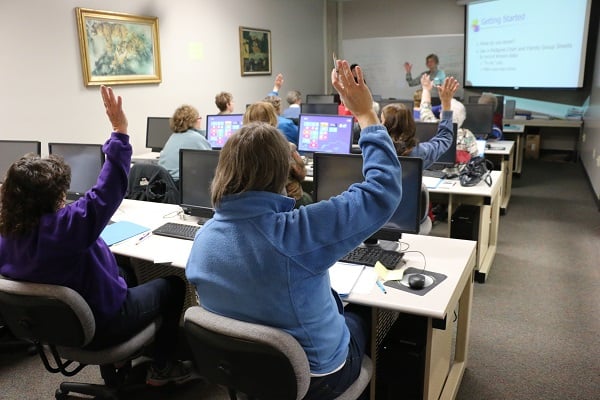Published on
Ready to Launch: Re-Envisioning the Preparation of Students for Online Learning

One of the most important questions a university must ask in welcoming new students is how they will orient or onboard incoming cohorts to ensure that the tools, resources and information required for success are adequately provided.
Most traditional face-to-face campuses provide varying iterations of a student welcome, ranging from a few hours to a multi-day event. The University of Arizona is no exception, conducting dozens of orientations over the summer to help residential freshmen acclimate to the university environment, as well as transfer student events catered to those coming from a community college. In Fall 2015, we launched our first fully online undergraduate degree programs. The traditional model of orientation clearly wouldn’t work and so UA Online had to think quickly about what to do for its new fully online students.
The UA Online Response
Just as various models exist for in-person orientations, there are many models available for full online learners as well, ranging from open-access videos, structured time-bound courses of varying lengths, and synchronous events, whether web-based or in-person.
After careful considerations and observations of our first incoming cohort, we elected to create a low-stakes, open learning environment that allows the student to engage as much as they feel is necessary prior to the beginning of classes, with access granted three weeks prior to the start of the semester to provide substantive opportunity to learn. To symbolize the journey that students undertake in beginning a degree program, this space was entitled “Launch Pad.”
Three key objectives guided the decisions surrounding Launch Pad’s structure:
1. Our students entered with a wide range of educational histories, some never attempting an online course, with others attending multiple colleges in an online format. With this in mind, we sought to provide a low-stakes environment allowing students to self-select how much practice in navigating the learning management system (LMS) they needed to build comfort and confidence prior to the first day of class.
2. As a Tier-One Research institution, our decentralized model empowers faculty to leverage outside tools and applications that facilitate the collaboration, discovery and assessment of their respective courses. We established a goal to introduce students to the oft-used Learning Tools Interoperability (LTI) technologies embedded into courses, allowing students to proactively set up accounts and practice use of these tools.
3. The online learning experience is inherently different from learning in an in-person format. For students looking to mentally prepare for online learning, we sought to create content that provides best practices through the eyes of a seasoned non-traditional student, as well as expectations surrounding important commitments (such as time needed for classes, academic integrity, etc.).
In addition to these concepts, we recognized that students receive an overwhelming amount of information in starting a degree program, whether it be regarding the admissions process, programmatic guidelines outlined by their advisors, navigating the financial aid landscape, or any variety of important transactions they must undertake. Throughout Launch Pad, the message is stressed that memorization is not required, just knowledge that they have a place where the information is stored for their current and future convenience. Launch Pad is designed to be a one-stop shop for success, whether it be prior to the start of classes or deep into a student’s academic career.
In addition to learning content (comprised of a mixture of videos, screencasts and step-by-step guides) and low-stakes tasks introducing users to course technology, students have the opportunity to practice taking quizzes in the LMS (in the form of an online learning readiness assessment), and submitting assignments utilizing the “Dropbox” tool (by practicing taking screen shots and uploading the document). Additionally, we incorporated a live module from an active class, giving students the opportunity to take part in real coursework. This particular class utilizes digital badging as the primary assessment tool, and designed a single badge to be transferable to the for-credit experience should students enroll in the full course.
Overall, the varied collection of experiential learning opportunities ensure that differentiated learner needs are addressed, giving the students meaningful practice with the very same assessment tools found in their future courses.
Lastly, a core component of the Launch Pad experience was the intentionality of the instructional design. The modules were prepared as a means of giving the students an accurate snapshot of what their courses would look and feel like, with design interface elements cut from the same cloth as the various courses within UA Online. Using effective practices for instructional and user experience design, each lesson and assessment is carefully aligned with the articulated learning outcomes designated for Launch Pad. Furthermore, as a means of fostering a constructivist learning community, many of the instructional videos were scripted, narrated and produced by students. Beyond mitigating learner anxiety over the unknown with a sneak peek into the actual online classroom, learners were able to interact with the module content through student-voiced videos, and to actively engage with each other using visual discussion boards.
Ultimately, with these mindful applications of emerging technology and design, we were able to foster within our students a sense of agency over their learning path, and offer them ways to connect with their peers well before the start of classes.
Key Questions to Ask in Developing Onboarding Support
There are a few key questions we asked ourselves that we feel are critical in the formation of an orientation experience for online learners.
Who are your learners and what are their online backgrounds?
While institutions tend to be more aware of diversity than many other organizations, that view can sometimes be limited to observable characteristics. Educational experience is another key point of diversity that should guide decisions in orientation practices; a student who has never taken an online course will have decidedly different needs than a student who has experienced online learning through various formats and LMS. While we strongly encourage participation in Launch Pad, we give choice out of deference to students who may not need a remedial experience to learning online.
What technological barriers may your students face?
Non-traditional students may experience feelings of inadequacy when they perceive a deficiency in their own technical readiness validating incorrect notions that college is strictly for those in their early twenties. We anticipated the need to ensure students had exposure to the LMS and integrated learning tools prior to the semester’s start to build confidence. After recent student feedback, we will be incorporating more optional basic technology refreshers, such as elementary computer skills and working with Microsoft Office Suite programs.
What resources are available?
One of the largest barriers to developing a program to orient online learners is not having the resources to do so. Partnership across multiple departments who are invested in the retention of students is vital to any onboarding program’s success. Overarching institutional support surrounding the success of online learners is equally critical. Launch Pad was developed as a collaboration between individuals supporting retention initiatives at the university and instructional design professionals who collaborate with faculty in the design of their online courses, as well as content specialists who traditionally play a role in residential orientations (i.e. Dean of Students Office). After taking inventory of the personnel and programs our institution possessed, we made the determination to develop a homegrown onboarding space that required no additional expense outside of staff hours.
The Future of Launch Pad
By housing Launch Pad within our existing LMS, we were able to leverage its native analytic tools to assess participation with the available materials. We have found an early high correlation between student engagement in the orientation space and success within the first term. In addition to helping overcome student anxiety and give access to those who will engage with the content, Launch Pad provides us an important data point that may give greater insight into a student’s potential investment in the program, allowing for early interventions for those with minimal pre-semester interaction.
Additionally, we are exploring the growing Adaptive Analytics field to further customize the experience in meeting students at their incoming knowledge and skill level. Continual assessment of metrics, student feedback and enhanced technology incorporated into the online classroom will continue to guide the evolution of Launch Pad, thereby helping us to further personalize the student experience.
Author Perspective: Administrator


